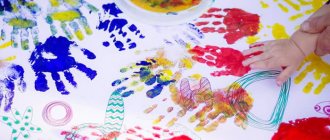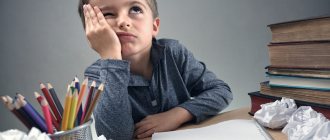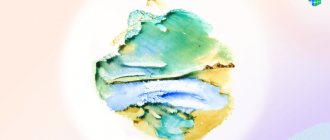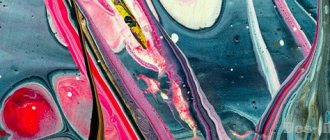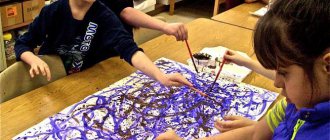What is nitcography
Thread painting is the technique of drawing with threads. It makes it possible to create unusual drawings and even entire paintings without the help of brushes and paints. For this activity you need wool threads and glue.
There are several ways to create this type of drawing. Threads soaked in paint are passed over paper, they are used to fill various parts of the appliqué, or they are used to make stamps.
The technique of thread printing came to us from Mexico. Masters created real masterpieces using only thick woolen threads. They impregnated them with a special mixture made from pine resin and wax.
Creating paintings using thread that has been dipped in paint (usually gouache) is called thread painting. This is one of the types of nitcography. It differs in that it does not require the use of glue.
This kind of “drawing” promotes the development of motor skills in children, so it is practiced in kindergarten in middle and senior groups among pupils 4-6 years old. According to experts, nitography helps develop abstract thinking and helps achieve beautiful handwriting when studying at school.
The benefits of learning different drawing techniques
Drawing for children is the first creative activity. Artistic activities contribute to the formation of a versatile, harmonious personality. They train fine motor skills and prepare hands for writing, teach attention to detail and concentration.
There are many drawing techniques, but non-traditional ones are considered especially useful for children. Creating drawings with palms, soap bubbles, stamps, threads and other original methods in childhood is much easier and more fun than with a pencil or brush. Having mastered various techniques, the child begins to think more broadly and can more accurately depict the intended image on paper.
Goals and objectives of using nitcography
So, what are the benefits of thread printing and thread writing techniques?
- Children get acquainted with new drawing methods that are just gaining popularity.
- Babies develop visual perception. They constantly have to look at individual objects and think about how to assemble them into a single picture or diagram. In addition, they improve the eye. They have to select those threads that are ideal in size for their design.
- Preschool children develop fine motor skills. This is very important especially in our time, when parents are trying to simplify their child’s life in any way, for example, buying clothes with zippers and shoes with Velcro instead of laces.
- Thanks to nitcography, creative thinking and imagination improves. For some children, a blank sheet of paper is an insurmountable barrier. They are unsure of themselves and are afraid to start something new. Nitography helps them to relax.
Plus, such techniques teach children perseverance and concentration both on the lesson as a whole and on individual details of the drawing.
Pictures with threads. Examples
Master classes for children should be simple and interesting, as in the pictures above.
A complex version of nitcography is accessible to an adult. A simple drawing of a flower for an activity with a child.
Cat - thread painting.
Materials for practicing nitcography
Nitography combines the use of rather unusual combinations of materials and tools. You will need:
- Working surface. This is the basis. It is desirable that it be rough. There are no restrictions when it comes to color. Choose what you like. You can take cardboard or any other thick paper, fiberboard, a piece of flannel fabric, a piece of plain carpet, etc. An A5 size base is sufficient. For variety, make templates for future drawings in advance.
- Wool, acrylic or cotton thread with a diameter of at least 2 mm. For kids in the middle group of kindergarten, you can take a nylon cord with a thickness of about 4 mm. The main thing is that it should not slide. Pre-cut the threads into pieces of the required length. Older preschoolers can do this on their own.
- PVA glue with a brush.
- Napkins, oilcloth, scissors.
- For thread printing, you will also need toothpicks or thin sticks, with which the child will align the drawing.
If necessary, you can take pencils, markers and other additional devices.
If you decide to start thread painting, prepare an A5 landscape sheet, threads about 45 cm long, multi-colored gouache, brushes and jars in which you will dilute paints with water.
Recommendations before starting work
It is important not to spoil the drawing by smearing. An upset child will not want to experiment later. Tips for parents before starting work:
- Selecting the color of the base material. The priority is white tonality. It makes it easier to control color changes. A wider palette is not forbidden.
- Material thickness. The ideal figure is 40-60 mm. Otherwise, the drawing will definitely be blurred.
- Thread length. The stated parameters should not exceed 35 cm. Children are uncomfortable working with such material. After all, it will be difficult to pull it out. If the thread is shorter than 30 cm, it will not be possible to lay it.
- Texture of the material. The floss adds elegance to the image. Acrylic and wool help create volume. It all depends on the age of the children. Some parents complain that wool reduces the quality of the pattern. It’s hard for kids to work with it at first.
- Possibility of replacing paint. You can use ink or ink. They will not harm the child.
- Buying paper. It all depends on the expected end result. The pattern appears more clearly on a smooth sheet. The rough surface allows you to create particularly unique images.
- Purchasing dishes. A one-time option will not work. The bottom of the container should maintain a flat surface. Otherwise, you can’t expect a clear application. Disposable products quickly become deformed. Some parents make do with a regular soap dish.
- Use of additional items. It wouldn't hurt to make a thread box for your child to keep his desk tidy. You will need felt-tip pens and pencils to draw the outlines.
- Application of frameworks. From childhood we need to instill the desire to create beautiful things. Without a frame, the drawings lose significantly. Baguettes are popular if there is no wooden frame. Its weight is insignificant, as is its price.
There is nothing complicated in the recommendations. They will simply help you create a unique image. There is no need to stop children if they want to show their maximum imagination. Prohibitions provoke a refusal of any kind of creativity in the future.
Nitography techniques
Most often, thread painting, drawing with stamps and appliqué are used in classes. Let's look at each technique in more detail.
Drawing with threads
The thread plays the role of a brush. The process looks like this:
- Dip the thread into paint of the chosen color.
- Once it is well soaked, place it between two sheets of paper. Can be laid in a zigzag. This will make the picture unusual.
- Lightly squeezing the paper and pull the thread out.
An interesting mark will remain on the sheets. It is either supplemented with details, or cut out and used as appliqué.
To make multi-colored prints, you need to take several different paints. Pour them in strips into a flat, low container. Saturate all the threads at the same time.
Drawing with stamps
First you need to make the stamp itself. To do this, you will need a base made of wood, foam plastic, thick cardboard or, for example, plasticine. Also take thick woolen threads, PVA glue, brushes and paints.
Apply glue to the base so as to repeat the intended pattern. It could be anything: a star, a flower, an animal, etc. Then carefully lay out the thread. Let the stamp dry. Then saturate the thread with dye. Attach it to a piece of paper and leave an imprint.
There is no need to make a stamp. If you wish, you can make do with a regular ball of yarn. Also saturate it with paint and leave an imprint on the paper.
Applications
In order to make an applique using thread printing, multi-colored threads need to be glued onto paper with pre-prepared contours. Perform a series of actions sequentially:
- Download and print the diagram from the Internet or draw it yourself using a simple pencil.
- Apply glue along the drawn contours.
- Carefully glue the threads. If there is excess, trim it off with scissors.
- Fill the middle of the design with threads. To do this, apply glue to the paper again. Lay the threads from the edge to the center along the perimeter. Another option is to chop up the threads and just sprinkle them on top.
For more information about this technique of thread printing, see the video below. There is a master class on creating the “Cherry” applique.
Master class on the topic “Nitcography”
Khmil Victoria Yuryevna senior teacher of the BDOU MO Dinskoy district "Kindergarten No. 50"
The material was sent for publication in the All-Russian printed collection of practice-oriented materials “Preschool and primary education - modern methods and technologies of teaching and upbringing” - July-August 2022.
MASTER CLASS ON THE TOPIC: “NITTOGRAPHY”
Goal: to expand the knowledge of teachers through familiarization with non-traditional drawing techniques, as a means of developing preschoolers for visual creativity.
- Objectives: to introduce teachers to the non-traditional technique of drawing with thread;
- consolidate the ability to work collectively, develop interest in learning something new;
- increase the level of teachers' skills.
Advertising message
Materials: • 2 sheets of A4 paper; • thread (not thin); • gouache, brushes, felt-tip pens; • water container; • a medium weight book.
Good afternoon, dear colleagues! Allow me to bring to your attention one of the unconventional drawing techniques - “Thread Drawing”. In my opinion, this is the most exciting drawing technique because you never know what will happen. I suggest that you continue to use this drawing technique in visual activities with children, because children really love to learn everything new and unusual, and this will have a beneficial effect on the development of our children’s creative abilities.
So, let's talk about what “Nitcography” is. First of all, this is a great way to have fun and usefully spend time. The essence of this unconventional drawing technique is to discern some kind of image in the blot and complement it with details. Thus, children do not need special skills to draw. All you need is imagination.
Nitography is also good because it can be used to study geometric shapes, numbers and even letters. In addition, you can briefly tell children what threadography is and give them a simplified master class, during which they can try their hand at this new direction.
This technique will help some children get rid of such a problem as “fear of a blank sheet.” By offering this drawing technique to children, you will definitely see their happy faces and real wizards in their eyes.
Practical tips: • it is advisable to take thin, light-colored threads so that you can see how it changes color; • do not use threads for knitting, they are fleecy and the image will be smeared; • the length of the thread should be no shorter than 40 cm and no longer than 50 cm, otherwise the thread will be inconvenient to pull out. • dilute the gouache in a small, flat container (palette or saucer). • the book must be no smaller than the sheet on which you will draw.
Work progress: Take the thread and carefully lower it into the paint, helping it to soak well. Smoothly lift the dyed thread and hold it at arm's length over a sheet of paper, and lower the thread onto the sheet in random order. Place the second sheet on top and press it with a book. We press the book with our hand and stretch the thread. We ended up with two identical prints. Let's take our drawings in our hands and carefully look at what we have come up with. And now I suggest you take your brushes and modify your drawing if necessary.
Result: Dear colleagues, I would like to ask your opinion - was my master class useful for you? Did you encounter any difficulties while doing this work? Thank you, colleagues! Your opinion was very important to me.
Our master class has come to an end, and in conclusion, I invite you to take a photo as a souvenir of today. Thank you for your attention!!!
You can see the table of authors and learn more about the collections HERE
Tips for Beginners
Even for beginners, there is nothing difficult in thread printing. Just follow a few simple tips:
- Choose thicker glue. The liquid will be absorbed into the base of the drawing.
- Apply glue only to a piece of paper (or other material), not to threads.
- Even scraps of thread or parts of unraveled knitted items are suitable for the job. Just straighten them.
- Use threads of different thicknesses and you will create a three-dimensional image.
- If you are a beginner, do not use curly or shaggy threads. It will be difficult for you to work with them. Give preference to smooth ones.
- It is recommended to draw the outlines of the future picture with a simple pencil. But some needlewomen do this with acrylic paints. They also sketch the middle of the picture. This helps avoid the appearance of gaps.
- You need to fill in the parts only after the thread has been glued along the entire contour.
- Try to keep the coils as evenly as possible and as close to each other as possible. If necessary, straighten them with a toothpick or a thin knitting needle.
- If you need to fill a round element, move in a spiral, and if you need to fill a long element, move from right to left.
- Once the painting is ready, iron it with a hot iron through wet gauze or cloth. This will help align the image and make it smooth.
And, perhaps, the main advice is to start with simple drawings. Move on to more complex images only when you learn how to form coils.
Stages of working on a drawing using thread writing technique
Let's give an example of working in the thread writing technique using whole thread and pieces.
"Flowers"
For drawings with threads on colored paper, it is better to use silicate glue so that there are no marks left after drying.
Instructions:
- “We place a sheet of green paper vertically, and use glue to make a “path” for the stem of the flower.”
- “We take a green thread and lay out the stem with it.”
- “We make large drops of glue and put leaves on them, placing the threads in a circle, as if wrapping a ball.”
- “Again we make large drops of glue, distributing it evenly over the entire area of the bud of the future flower.”
- “We fill the element with pieces of thread, laying out first one layer, and then the second in the other direction.”
- “Add a couple of green threads for the calyx of the flower.”
Photo gallery of drawings with solid thread
The house and tree can be made without pre-applied contours
In this drawing, folding threads in a spiral and in a circle is practiced.
Such plots do not require small folds on the threads
Applications for clothes made from thread printing
Appliqués made from threads on clothes, bags, and interior items look very beautiful. The use of special technologies and materials allows us to create moisture-resistant works.
Items on which such applications are placed must be carefully hand washed. Threads for appliques are selected of high quality, non-fading ones.
To create pictures that can be washed, polymer waterproof transparent glue is well suited.
- As a base, rubberized fabric or dense polyethylene is used, which can be easily peeled off after drying.
- An image is applied to polyethylene or rubberized fabric. If the base is transparent, the drawing can be placed under it.
- On top, for a kind of reinforcement of the base, a special mesh is placed. Transparent acrylic or other transparent polymer glue is applied to it little by little, in separate sections, so that the glued area does not have time to dry.
- Take pieces of pre-prepared threads of the required colors. It is most convenient to work with 20 cm pieces. More experienced craftsmen work with small balls. Many drawings begin by gluing the outline of the figure with black thread. Attach in circles or lead strings from the center to the edges.
You should not cut the threads exactly near the edge; it is better to leave extra millimeters and then wrap the picture behind the baguette. With lines you should try to convey the natural direction of movement of waves, shadow, sun rays, curliness of clouds, leaves on trees, etc., then the drawing turns out beautiful and natural.
The application must be dried well, carefully remove the polyethylene or rubberized fabric and attach it to clothing, upholstered furniture or other voluminous object. This wonderful decoration will last a long time.


